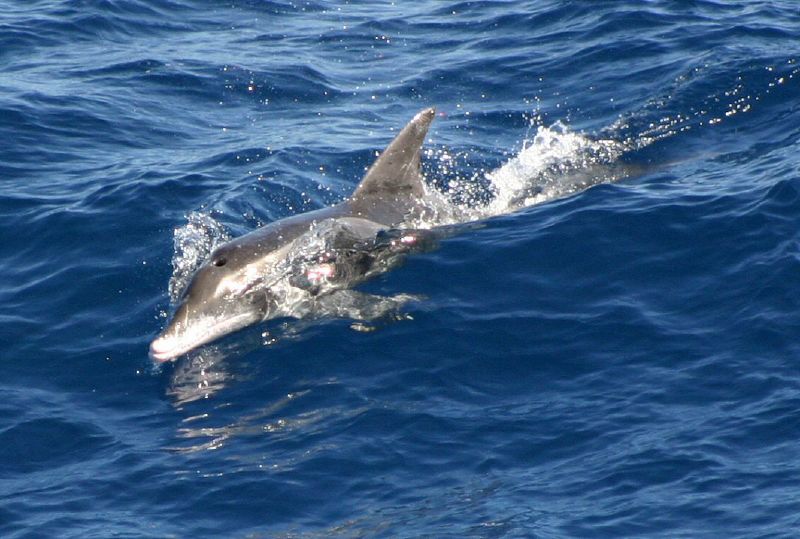
Rough-toothed Dolphin Facts
- This magnificent denizen of the depths most frequently goes by the descriptive common name of the Rough-toothed Dolphin. For the moment, the amazing creature has no other accepted general name. Though not unknown, that’s uncommon.
- Meanwhile, scientific professionals perhaps know it better by its technical moniker. Fortunately for the layman, that’s a relatively simple term to pronounce, as such things go. That’s because the mammal holds the formal moniker of Steno bredanensis.
- The remarkable creature received that formal appellation due to the efforts of René-Primevère Lesson. The respected French naturalist accomplished the first recognition of the animal as a separate and distinct species. That action occurred in 1828.
- The natural wonder also stands out for several reasons. It currently represents the only member of its genus known to science. Another reason pertains to its form, though. Despite its physical similarity to one group, the animal actually belongs to another one.
- Thankfully, the intriguing Rough-toothed Dolphin seems to be maintaining a population base that’s both stable and sufficient. That pleasant state also appears to hold true across its entire range. The IUCN therefore list the dolphin as Least Concern.
- It nevertheless should be considered as facing several potential threats to its continued existence, at least. Most of these perils stem form the actions of mankind. They include the related dangers of habitat loss and the ongoing effects of climate change.
Related Articles
Rough-toothed Dolphin Physical Description
The beautiful Rough-toothed Dolphin typically captivates those fortunate enough to encounter it. Unlike some of Nature’s marvels, though, it does so for more than just its beauty. That’s true since this species also ranks as a somewhat large member of its Family.
The dolphin also follows a pattern prevalent to mammals. That’s due to the fact that it displays a certain degree of the physiological characteristic of sexual dimorphism. In its case, however, this trait manifests itself purely in terms of sheer physical dimensions.
More precisely, males attain a larger average size than their female counterparts. That difference is relatively minor, though. Overall, individuals reach a mean body length ranging from approximately 6.9 – 9.3 ft (2.09 – 2.83 m). Though rare, exceptional specimens occur.
Weights for the species understandably also vary accordingly. On average, this ranges from between 198 – 342 lb (90 – 155 kg). Again distinguishing themselves somewhat, however, the males typically have the greater masses. This creates a tendency toward a stockier build.
In terms of coloring, though, both sexes of the lovely Rough-toothed Dolphin present the same basic pattern. This principally consists of a grizzled gray shade across much of the body. Yet, the lips, throat, and abdomen show a very distinctive pinkish-white hue.
The cetacean also sets itself apart due to the nature of its teeth, as the name implies. That’s because these possess a roughened surface, created by many narrow ridges. It also has a slender nose and conical head, both of which are different than among other dolphins.
- Kingdom: Animalia
- Phylum: Chordata
- Class: Mammalia
- Order: Artiodactyla
- Family: Delphinidae
- Genus: Steno
- Species: S. bredanensis
Rough-toothed Dolphin Distribution, Habitat, and Ecology
The gorgeous Rough-toothed Dolphin appears to have evolved as native to a broad swathe of the marine regions of the earth. The full extent of that zone of habitation might surprise some of you, though. That’s true since it’s known in a large number of regions.
These include the Indian, Atlantic, and Pacific Oceans, for starters. Yet, the intrepid creature also makes its presence known within the confines of the Mediterranean Sea. Inside of that territorial range, however, researchers remain as to its precise population distribution.
Throughout its known habitat range, though, the animal displays decidedly strong preferences regarding its choice of where it calls home. Most individuals and groups spotted appear in either tropical or subtropical waters. Few are ever seen outside such environments.
Depth also seems to play a very important factor in its choice of ecosystems. Nearly all sightings, in fact, take place far beyond the local continental shelf. Typically, the maximum ocean depth in the regions the mammal lives in equal or exceed at least 0.62 mi (1 km).
The Rough-toothed Dolphin evolved as primarily social in nature. Most specimens sighted therefore appear in groups. These usually range from 10 – 20 in number, but can range from 2 – 90. Researchers believe the larger groups to be temporary in nature, though.
It also evolved as carnivorous in nature, like its relatives. Full details on its dietary preferences remain undetermined, however. Yet, this seems to include varieties of fish, squid, and octopi. In turn, its main predators seem to be Orcas and various species of shark.
Species Sharing Its Range
Check out our other articles on 3 Amazing North American Amphibians, Great Potoo, Cheddar Gorge, Maned Wolf, Mountain Laurel, East African Lowland Honey Bee, Black Mamba
